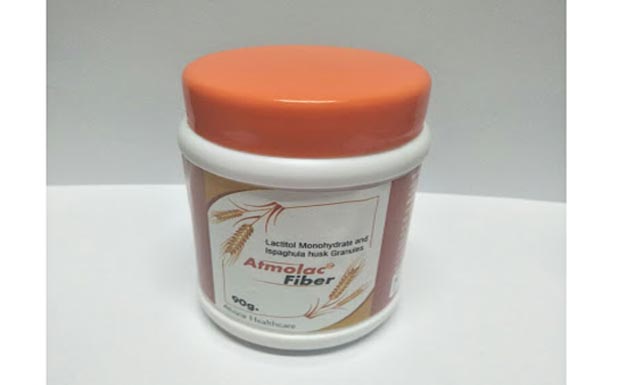
Composition
- Each Sachet Contains:
Lactitol Monohydrate BP 10 G
Ispaghula Husk IP 3.5 G
Packing
- 90G Jar
MRP
- 249
Overview
This combination is provided by combining a bulk-forming laxative in the form of psyllium husk (Ispaghula husk) with an osmotic laxative such as lactitol for
Idiopathic constipation and is used to prevent or treat constipation.
Constipation is a common problem which can be caused by a number of things. Not eating enough fiber or not drinking enough fluid can cause constipation.
Some conditions can cause constipation such as such as pregnancy or lack of exercise or movement (such as being ill in bed) or some medicines.
It is a common problem for adults and pediatric patients and can generate considerable suffering for patients due to both the unpleasant physical symptoms and
psychological preoccupations that can arise.
In this combination, Lactitol is an osmotic disaccharide laxative that increases fecal volume and stimulates peristalsis.
Ispaghula husk helps relieve constipation and as a laxative, works by increasing the bulk of stools, which encourages bowels to move the stools through
digestive system, which in turn relieves constipation.
Bulk-forming laxatives absorb water and expand in the colonic lumen; in contrast, osmotic laxatives retain water in the colonic lumen by osmosis. So, both
laxatives act to retain water in the colonic lumen thereby counteracting the normal dehydrating action of the colon. By suppressing the dehydration action of the
colon, the osmotic laxative produces a fecal stream which is softer, bulkier and easier to expel.
These laxatives also help to produce formed stools, without any systemic toxicity.
Indications
- Constipation
- Fissures
- Haemorrhoids
- Pregnancy
- Pre- and post-operative conditions
- Mild to moderate hypercholesterolaemia
- Prevention of hepatic encephalopathy
- Chronic cholecystitis
- Acidity
- Anorectal disease
- Irritable bowel syndrome
- Inflammatory bowel disease or other types of diarrhea
Pharmacology
Lactitol Monohydrate:
Lactitol is an osmotic disaccharide laxative that increases fecal volume and stimulates peristalsis and analogue of lactulose.
Osmotic laxatives are widely prescribed in the management of constipation due to their superior efficacy, tolerability and safety
in pediatric patients, during pregnancy and elderly population. With its more pleasant taste, it is better tolerated and more palatable.
It is used in the management of hepatin encephalopathy and in constipation. The efficacy and tolerance of lactitol and lactulose are similar,
with a trend for more frequent stools with lactitol. Lactitol has calorific value of 2 kcal/g (8.5 KJ/g) and has no effect on blood glucose
levels. It can, therefore, be given to diabetes patients. Lactitol is a disaccharide derivative consisting of galactose and sorbitol,
which is only minimally absorbed and is not, hydrolysed by the disaccharidases of the gastrointestinal tract and, thus, reaches the colon
unchanged. In the colon, it is broken down into short-chain organic acids, mainly acetic, propionic and butyric acid, by the intestinal
flora, in particular by the bacteroides and lactobacilli, thus acidifying the contents of the colon. The effect of this acidification reduces the
absorption of ammonia. The transformation of lactitol into low-molecular weight organic acid results in an increase in osmotic pressure in the colon,
thereby causing an increase in the stool water content and stool volume, which explains the laxative affect.
The mechanism of action of lactitol in hepatic encephalopathy is most likely related to suppression of the absorption of unionized ammonia via lowering of colonic
pH; a cathartic action also enhances faecal nitrogen excretion and decreases intestinal transit time, with a reduction in the time for production and absorption
and other potential toxins.
Mechanism of Action of Lactitol:
In the colon it is broken down to short chain organic acids and acidify, this results in an increase in osmotic pressure in the colon, thereby causing an increase in the stool water content and stool volume which explains the laxative effect.
Pharmacokinets of Lactitol:
Absorption: Lactitol is not significantly absorbed in the small intestine; only 0.5% to 2% of a dose is partially absorbed as
unchanged lactito
Metabolism: Absorbed volatile fatty acids are metabolized in the colon
Excretion: 6.5% excreted in the feces. Small amounts of unchanged lactitol appear in the urine (2% or less of a dose)
Ispaghula:
Botanically, Isabgol (also called Psyllium & Ispaghula) is Plantago ovata. Sat Ispagol (also called Psyllium Husk & Isaghula Husk) is husk outer membranous covering of the Plantago ovata seeds, which is useful in relieving constipation and has other therapeutic benefits and uses. Ispaghula husk has gentle laxative action that depends on the fiber content, so it is not actually true purgative. It can be categorized under bulk forming laxatives. The flour of Isab gol Husk is added in multigrain flour to enhance nutritive value as well as fiber content of cereal flours. It can absorb 14 times more water than its weight. Therefore, the high amount of liquids or water should be consumed while taking Ispaghula husk. It will also help preventing immediate side effects like choking.
Mechanism of Action of Ispaghula Husk:
Bioavailability: Psyllium is hardly absorbed
Onset of action: 24 to 72 hours
Metabolism: Metabolized in the colon
Elimination: More than 70% is excreted unaltered through the stool
Side Effects:
Temporary increase o f flatulence and abdominal distension, Rectal irritation, Dangerous potassium loss, Headache, Confusion, Rash, Hypersensitivity reactions.
Contraindications:
Organic intestinal obstruction.
Precautions:
It should not be admin istered to patients with intestinal obstruction, fecal impaction, colonic atony or those with known hypersensitivity to Ispaghula or Lactitol.
Pregnancy and breast-feeding:
This combination should be prescribed only if the potential benefits outweigh the potential risk to the foetus.
Storage
Store at a room temperature, protect from light and moisture.